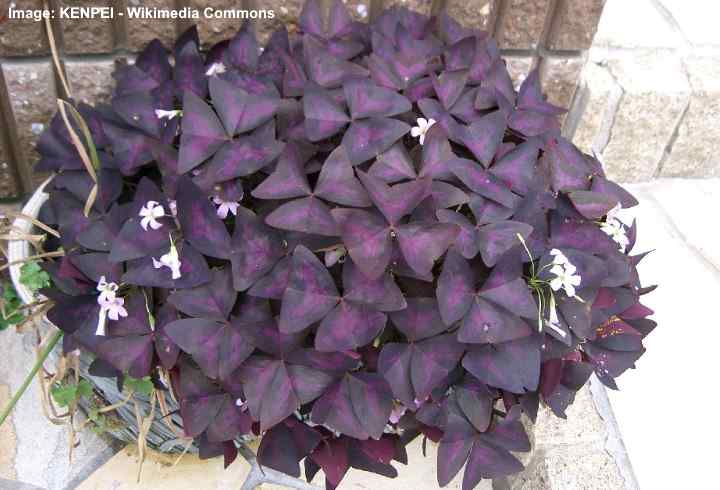Oxalis Triangularis (Purple Shamrock): Care and Growing Tips for False Shamrock Plant

The purple shamrock (Oxalis triangularis) is a flowering perennial plant with triangular dark purple leaves. The purple shamrock (also called purple clover) grows as a low-growing foliage plant in gardens or as an attractive potted houseplant. Other names for this purple-leafed plant include Love plant, purple butterfly plant, false shamrock or purple Oxalis. Due to the distinctive shape of the leaves and its dark purple almost black color, it is a stunning indoor plant for a sunny spot in your house.
How to care for purple shamrock: For the Oxalis triangularis to thrive, grow in bright light and plant in fertile, moist potting soil with good drainage. Only water the purple false shamrock plant when the soil is partly dry and keep medium humidity levels. The ideal temperature range is 60°F to 75°F (15°C – 23°C). Fertilize every three or four weeks.
The purple-leaf false shamrock is a bulbous plant in the family Oxalidaceae, which is a type of wood sorrel. The flowering plant produces white blooms with purple and pink hues. The deep purple or maroon leaves are trifoliate, which is similar to clovers or shamrocks—hence the common names purple clover or false shamrock.
An interesting feature of these purple love plants is the way their leaves close at night. The leaves fold down at night time, similar to an umbrella. This movement is similar to other unusual houseplants, such as the sensitive plant (Mimosa pudica). Other houseplants with leaves that move are species of prayer plants.

The leaves of oxalis triangularis (purple shamrock) close at night
The Oxalis triangularis grows to about 20” (50 cm) tall and has a similar-sized spread. The purple leaves are formed by three triangle-shaped leaflets giving them the look of a butterfly—this is why the plant is also called a purple butterfly plant. The perennial plant declines (dies back) usually in summer, but regrows again about a month later. So, even though the false shamrock looks as if it’s dying, it is probably just going into its dormancy stage.
The plant also has varieties with leaf colors other than purple. There are cultivars such as the red Oxalis triangularis and burgundy shamrock.
Although this unusual purple houseplant seems fussy, it is fairly easy to care for. This care guide for the purple Oxalis aims to tell you everything you need to know about looking after this plant.
Oxalis Triangularis (Purple Shamrock) Care Guide

Purple oxalis is also called purple butterfly plant and false shamrock
How can you make sure that your Oxalis triangularis plant grows well? Read on to find out the best care tips for your purple-leafed houseplant.
Purple Oxalis Triangularis Light Requirements
For healthy growth, put your false shamrock in a bright location where it gets a few hours of daily sunshine. Protect the plant from too much direct sunlight, or you could get white spots on the leaves. But, plenty of light is needed to keep the leaves dark purple. Bright light also stimulates the leaves to open to create the clover or shamrock look.
Purple oxalis plants can grow in low-light conditions. However, they can develop the tendency to become leggy as the stems stretch to get more light. If foliage seems sparse, prune the plant and move it to a brighter location.
If you are growing a purple false shamrock in your yard, choose a location with dappled sunlight. You could also plant it in containers to add stunning dark foliage to a patio, deck area, or balcony.
The Best Soil for Oxalis Triangularis (Purple Oxalis Plant)

To care properly for purple shamrock plant make sure to use well-draining soil
Oxalis triangularis (purple shamrock plants) need rich, fertile soil that is well-draining. The best kind of porous potting mix should be a mixture of potting soil and peat. The aim is to get a potting mix that retains enough moisture but doesn’t become soggy or waterlogged. Overly-damp soil causes the root bulbs to rot.
You can tell if your potting mix provides enough drainage when you water it. For example, water should never pool on the surface. Also, when you water a purple false shamrock, the water should quickly start draining out the bottom. If water drains poorly, you will get several issues with your plants, such as fuzzy white mold, fungus gnats, or diseased roots.
If the bulbs take up too much room in the pot it can also affect drainage. But there is more information about that later in the article.
How to Water Purple Shamrock (Oxalis Triangularis)

Don’t water your purple oxalis plant when it dies back during its dormancy period
The most crucial care advice for growing a purple Oxalis triangularis is to water it properly. To water your oxalis houseplant, pour enough water until it drains out the bottom. Then, wait until the top part of the soil dries out before watering again. Deep watering gets enough moisture to the roots, and letting it partly dry out prevents bulb rot.
Rather than water a purple oxalis plant on a regular schedule, water only when it needs it. How can you know when to water the purple houseplant? Press firmly on the soil to test for moisture. If the soil is dry, then it’s time to water it. If not, wait a few days until the soil dries out a bit more.
Remember: your purple false shamrocks need more watering in summer than in winter. Also, when the plant dies back, don’t water it as it becomes dormant. But let it rest for four weeks in a dark cool place.
Here are some more Oxalis triangularis care tips when it comes to watering:
- Use water that is at room temperature.
- Only use filtered or rainwater. If that’s not possible, let water sit out for 24 hours so that harmful chemicals evaporate.
- Water deeply to nourish the roots.
- Never over-water the plant, or the bulbs may start rotting.
Temperature Requirements for False Shamrock

When growing indoors, purple oxalis houseplant grows well in cooler temperatures
Average room temperatures are ideal for growing purple shamrocks in pots indoors. So, keep the temperature between 60°F and 75°F (15°C – 21°C). If you are growing purple false shamrocks outdoors, they grow well in USDA zones 8 to 11. The minimum temperature outdoors is 55°F (13°C) during nighttime.
Most houseplants—the butterfly purple plant included—need protection from temperature extremes. For example, the sun shining directly through a window on the plant can make it too hot. Also, keep away from cold drafts, hot radiators, or direct air conditioning airflow.
Purple shamrocks thrive in cooler rooms with even temperatures.
Purple Shamrock Indoor Care: Humidity
There are no special care requirements for false shamrocks when it comes to humidity. Average room humidity is ideal, and the plant doesn’t require misting to increase air moisture.
Sometimes during winter, household heating can dry out the air. So, if you notice that the leaves are wilting, you could give the plant a light misting with a fine spray. Just remember never to water the plant unless the soil is dry.
Fertilizer Requirements For Oxalis Triangularis (Purple Shamrock)

Fertilize your purple butterfly plant monthly during the growing season. The best fertilizer to use for purple false shamrocks is a diluted houseplant liquid fertilizer. Alternatively, you can use a slow-release fertilizer, which you only have to use at the start of the growing season and then three months later.
An issue that many houseplants have with added fertilizer is a buildup of mineral salts. Because minerals salts don’t flush away in garden soil, they tend to accumulate in potted indoor plants. To avoid a fertilizer buildup damaging plant roots, flush the soil occasionally.
To care for indoor plants by flushing the soil, this is what you should do:
- Take your purple shamrock plant to a sink or bath.
- Gently run water through the soil for two to three minutes to flush out excess mineral salts.
- Allow all the water to drain out the pot.
- Place the plant in a bright location.
- Resume watering when the top layer of soil has dried out.
During the fall and winter, purple oxalis plants go into dormancy. So, you should stop feeding and watering during this time.
How to Prune Purple Shamrocks (Oxalis Triangularis)

False purple shamrocks have minimal pruning requirements. The plant has a natural bushy growth indoors and outdoors. The only pruning you need is to pinch off dead stems when the plant declines or dies back.
If you notice that the vibrant purple foliage starts to brown, wait until the leaves and stems dry out. Now is the time to cut back oxalis plants. Prune off the dead leaves and stems and move the plant to a cool, dark place. Allow the houseplant three to four weeks to rest. After that, return to a bright location and water as normal.
Oxalis Triangularis Propagation
You can divide a purple shamrock by dividing the bulbs to propagate a new plant. The best time to propagate false purple shamrocks is in the dormancy period. You only need to gently separate the bulbs and then replant them in a new container.
To propagate a purple oxalis shamrock, this is what you should do:
- Wait until the plant dies back, and then you trim off any dead or brown foliage.
- Gently ease the purple shamrock from the container and remove the dirt from the bulbs.
- Divide the bulbs with your hand or use a sterilized knife.
- Repot the new bulbs in pots and the appropriate potting mix.
Planting (Oxalis Triangularis) Purple Shamrock Bulbs
Planting purple false shamrock bulbs couldn’t be simpler. The bulbs grow easily in well-draining potting soil, and very soon, new stems and vibrant purple foliage will start to grow. This is how to pant Oxalis triangularis bulbs:
- Take a container that has drainage holes and fill it one-third full with the appropriate potting mix.
- Put three or four purple shamrock bulbs in the container a few inches apart.
- Fill the pot with potting soil so that the shamrock bulbs are around 1.5” (4 cm) deep.
- Thoroughly water the potting soil to stimulate growth.
- Place the pot in a bright, warm location.
- After two to three weeks, you should notice some new growth.
- Only water the new plants when the top layer of soil has dried out.
When growing Oxalis triangularis bulbs, the most crucial care advice is not to water so much that the soil becomes overly damp. So, avoid the temptation to water the newly growing oxalis bulbs too much.
Repotting Oxalis Triangularis
Oxalis triangularis (purple shamrock) plant only requires repotting every few years. There are two reasons to repot a purple oxalis plant—refresh the potting soil or transfer it to a larger container. The guidelines to repot an oxalis plant is the same for plant purple shamrock bulbs.
If you are only refreshing the potting mix and want your triangular-leafed plant to grow larger, choose a new pot 2” (5 cm) larger than the current one.
If you are separating the offsets to propagate new shamrock plants, change the potting soil, but use the same size of pots.
Is Purple Shamrock Poisonous?
Purple shamrock (oxalis triangularis) plants are toxic to cats and dogs. The purple-leafed sorrel is in the family Oxalidaceae, which contains toxic oxalic acid. The American Society for the Prevention of Cruelty to Animals (ASPCA) lists shamrock plants as being toxic to cats, dogs, and horses. (1)
However, because the plant’s leaves taste bitter, it’s unlikely that your pets will start chewing them.
Oxalis Triangularis (False Shamrock) Dormancy Period
Most bulb plants—purple shamrock included—have a dormancy period when it seems that the plant has died. You can tell when a false shamrock is getting ready to go dormant because the leaves stay shut in daylight, and it seems to lack vitality. This is a natural occurrence, and the purple plant usually returns to life after some rest.
If you notice that the plant seems to be dying, it is probably a sign that it’s going into a rest period. So, hold off watering and wait until the leaves and stems dry out. Prune any dead foliage and put the plant in a shaded, cool place. Wait for three to four weeks and then return the pot to a bright location and water to help bring your purple shamrock back to life.
Common Diseases and Pests that Affect Oxalis Triangularis
Like any type of houseplant, pests and disease can affect purple shamrock plants. The most common type of shamrock disease is root rot caused by over-watering. Most commonly, mealybugs and spider mites can damage your purple foliage plant.
Purple shamrock pests
Mealybugs—These pests look like bits of white fluff or cotton that are easy to spot against the dark black or purple foliage. Some people say they look like white spots on purple plant stems.
Spider mites—The classic sign of spider mites is webbing on or under purple shamrock foliage. The spider webs are easier to spot than the mites.
Please read our article on how to get rid of bugs in houseplants to find out how to treat pests than can kill a purple shamrock plant.
Purple shamrock diseases
Fungal diseases are the most common type of conditions that can affect the growth of your Oxalis triangularis (purple shamrock plants). What’s the most common cause of houseplant fungal diseases and poor growth? Over-watering.
If you notice weak growth, white mildew, or drooping leaves, check the soil moisture. Purple shamrock plants thrive in moist, but not overly-damp soil. To resolve problems with fungal diseases, this is what you should do:
- Scrape off any signs of white mold and remove the top 1-inch (2.5-cm) layer of soil.
- Stop watering your plant until the upper layer of soil dries out.
- If your plant doesn’t recover, repot with a fresh potting mix and water appropriately.
FAQ About Growing Purple Shamrock (Oxalis Triangularis)
Do you want to know more about this fascinating purple butterfly plant? Here are the answers to many questions that people ask.
Why is Oxalis triangularis called false shamrock?
The name “false shamrock” comes from the fact that the plant has three petals similar to shamrocks or clovers. However, the plants are from different families and have differently shaped leaves. Clovers and shamrocks have small oval leaflets, whereas the purple shamrock has triangular leaves.
What are those white spots on my purple shamrock plant?
White dots or patches on purple shamrock leaves could be due to several causes. Powdery fungus can appear as white spots or you could have a pest infestation. Other reason for white leaf spots could be sun damage.
If the soil is overly damp, then the creamy-white markings on the leaf could be a fungal issue. Reducing watering frequency should help resolve the problem. If the white spots become dry and create holes, it’s probably sun burn. So, either move the pot out of direct sunlight or provide some shade.
Do purple shamrocks flower?
Growing in the right conditions, false shamrocks (oxalis triangularis) flower every spring. They bloom with small white trumpet-like flowers. Looking up close, you will notice delicate hues of pink and purple.
Can purple shamrocks be planted outside?
Oxalis triangularis thrives as a low-growing foliage plant in bright, sunny outdoor locations. The stunning purple leaves make attractive borders or small bushes in backyards. If you live in cooler climates, you can dig up the bulbs in fall and replant them again in spring to protect them from frost.
Do purple shamrock leaves close at night?
False shamrocks are sensitive to light levels, and their leaves close in low light. In the evening, the leaves fold down, making the stems look like arrows pointing upward. When light is brighter, the leaves open again.
How long does a purple shamrock plant live?
Purple oxalis plants grow throughout the year, apart from a dormant period usually in summer. These perennial foliage plants need to rest for a month or so. During this time, the purple leaves turn brown and die back. So, don’t make the mistake of thinking your plant has died. Move the plant to a cool dark area for two to four weeks. After that, move to a bright location and water it thoroughly to revive your plant.
Why does my purple shamrock seem to be dying?
If you are caring for your purple faux shamrock properly, it should grow year after year. So, any appearance of your plant dying probably means it’s going into dormancy. After a few weeks, the gorgeous purple or maroon leaves should return.
Why are the Oxalis triangularis purple leaves turning yellow?
Too much water is usually the reason for purple leaves starting to yellow. The yellowing leaves could be due to over-watering or poor soil drainage. To help bring back its purple vibrancy, don’t water until the top 1” (2.5 cm) of soil has dried out.
Related articles:
